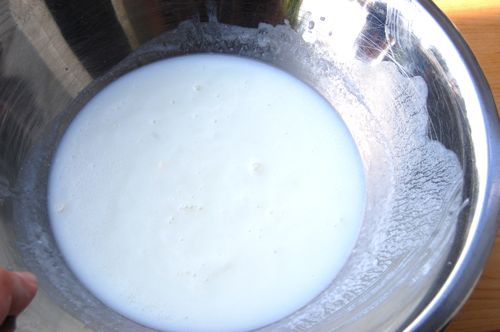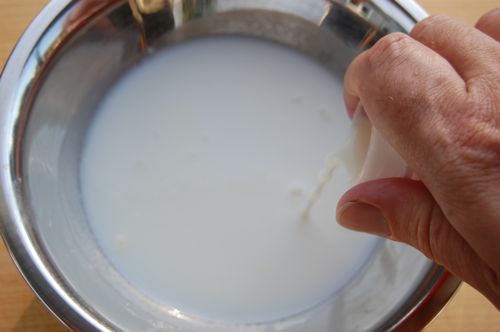Making Buttermilk
I’ve always felt that “buttermilk” is a misleading term. It implies a richer form of ordinary milk, when in fact most buttermilk is about as rich as low-fat milk. That makes a lot of sense when you consider where buttermilk comes from, for it’s the liquid that’s leftover when fat (butter) is removed from cream. But if that’s the case, why is buttermilk so thick? And more than that, why is it tangy? The answer to both questions is: lactic acid bacteria. It’s bacteria that make the acid that curdles the proteins that live in the house that Jack built….er, that makes buttermilk thick and tangy. (Sorry, too much time singing nursery rhymes).
But then where do the bacteria come from, and how do they get into the milk to begin with? The answer is that lactic acid bacteria are pretty much everywhere: in the air, on container surfaces, even in the udders of cows. Except when milk is irradiated, live lactic acid bacteria and milk are essentially inseparable. So the question isn’t really where the bacteria come from, but how and why the bacteria are allowed to become so numerous that they affect the taste and texture of milk.
The answer to that is that lactic acid bacteria, like most microbes, will grow and reproduce given food, water, time, temperature and the right pH. Milk provides the food, water and pH and conditions around the farm provided the time and temperature. For farmers of old had no refrigeration equipment. When a cow was milked, the milk went into a container where it sat, warm, a perfect environment for microbial growth.
The upshot was that all milk and cream once was, at least to some extent, sour. Soured cream makes sour (“cultured”) butter, and, by extension, sour buttermilk. It wasn’t very long ago at all that people — especially kids and farm hands — loved to drink buttermilk. It’s low in fat which means it chills well, and the tanginess is enlivening to the taste buds. Yuck, you mean people actually drank that stuff??? Yes they did, though it’s important to remember that homemade buttermilk is/was much milder — and thinner — than the kind we buy in stores today. Store bought buttermilk is extremely “ripe” by conventional standards, which makes it less enjoyable to drink but better for leavening quick breads.
And that is/was the other great value of buttermilk on the farm. Combined with baking soda acidic buttermilk creates a reaction that raises the buttermilk biscuits and pancakes we associate with country living.
So it’s versatile stuff, yet it’s poorly understood at a time when so few of us live on farms anymore. Mostly we just buy a jug when a recipe calls for it. However it can be made at home. The easiest way to make buttermilk is to simply make some cultured butter. You get it as a by-product. See?

You just knead the butter and pour it off. Knead and pour it off. In time you have quite a bit of buttermilk.

Just store it in an airtight container and use it as you would any other buttermilk. You can even drink it if you like. If you find it too strong you can add a little milk to it. Or ice. (Very nice).
But then what if you were making sweet cream butter? That’s not made from soured cream, but from fresh cream, which leaves “sweet” buttermilk behind. It tastes just like low-fat milk (because that’s essentially what it is). Drink it, or, if you want to make buttermilk from it, add a little soured buttermilk (or sour cream or yogurt) to it…

…stir…

… and let it ferment overnight. All done! I should add here that if you want to make buttermilk exclusively for drinking, you can control the tanginess by only letting it ferment for a few hours. Fermented milk drinks are enjoyed the world over, and for good reason. I think they’re a tradition we should bring back here in the States.
Oh, and if you need to make “quick” buttermilk for baking, just add a tablespoon of vinegar to a cup of low fat milk. It’s horrible stuff for drinking, but it will work just fine in recipes.
It’s ok If I’ve made buttermilk and butter from heavy cream? Or is better from sour cream?
It depends on the flavor that you want. If you like a tangy buttermilk, let your heavy cream sour a bit. If you prefer it mild, use fresh (also known as sweet) cream. Thanks for the question!
hi joe, this is exactly how our grandmothers (and theirs..) in india made butter and buttermilk; the only difference is that it was made from home made fresh yogurt. No fancy gadgets.. just an earthern pot (said to yield thicker curds) with a wooden beater and rope and we grandchildren would sit around it waiting our turn to churn out the butter and have the first taste of it….
Cultured milk drinks are making a comeback in my part of the country at least 🙂 At the local grocery, we can get Kefir–which my Swedish grandparents very favorably compare to the “field milk” that they used to drink as kids.